Samsung SDI Co Bundle
Who Really Controls Samsung SDI?
Uncover the ownership secrets of Samsung SDI, a powerhouse in the EV battery and energy storage markets. Understanding who owns Samsung SDI is key to grasping its strategic moves and future potential. From its roots as a joint venture to its current global dominance, the ownership structure has been a driving force.
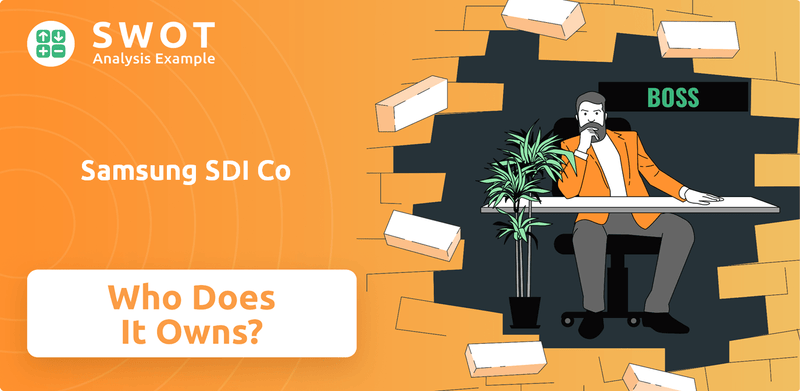
Delving into the question of "Who owns Samsung SDI?" unveils a complex web of influence, from its parent company to key institutional investors and public shareholders. Knowing the Samsung SDI shareholders and their stakes provides crucial insights into the company's direction and investment strategies. This Samsung SDI Co SWOT Analysis, alongside an understanding of its ownership, offers a comprehensive view of its competitive landscape and future prospects, making it essential for anyone interested in the company's trajectory and investment potential.
Who Founded Samsung SDI Co?
The story of Samsung SDI begins in 1970 as Samsung-NEC Co. Ltd., a joint venture. This partnership between Samsung Group and NEC Corporation set the stage for its early ownership structure. The initial focus was on electronics components, particularly cathode ray tubes (CRTs), leveraging the strengths of both parent companies.
The ownership wasn't about individual founders, but rather the corporate entities. Samsung Group, led by Lee Byung-chul, provided the strategic direction and overall framework. NEC Corporation contributed its technological expertise, especially in CRT technology. The early agreements between these companies were key, defining operations, profit sharing, and control.
Early backers were essentially the parent companies, providing the necessary capital and resources. The vision was collaborative, combining Samsung's industrial might with NEC's technological know-how. This joint venture model has evolved significantly over time, with the ownership structure now primarily under the Samsung Group umbrella. This shift reflects a move from manufacturing CRTs to a leading position in batteries and electronic materials.
Samsung SDI began as a joint venture between Samsung Group and NEC Corporation.
The initial ownership was divided between Samsung and NEC, not individual founders.
Samsung Group provided the overall strategic direction, while NEC offered its technological expertise.
Early agreements focused on technology transfer, manufacturing, and market distribution.
The ownership structure has evolved, now primarily under the Samsung Group.
The company has shifted from CRT manufacturing to batteries and electronic materials.
Understanding the Target Market of Samsung SDI Co is crucial when examining its ownership. The evolution of Samsung SDI's ownership structure reflects its strategic shifts and growth. The initial joint venture model has transitioned to a more consolidated structure, primarily under Samsung Group. This change aligns with the company's expansion into new markets and technologies, such as battery manufacturing and electronic materials. The shift in ownership also reflects the company's increasing focus on the electric vehicle (EV) battery market, a sector experiencing significant growth. In 2024, the global EV battery market is projected to be worth over $100 billion, with continued growth expected in the coming years.
- The primary focus was on cathode ray tubes (CRTs) initially.
- The ownership structure has evolved over time.
- The company's focus has shifted towards batteries and electronic materials.
- The majority shareholder of Samsung SDI is Samsung Electronics.
Samsung SDI Co SWOT Analysis
- Complete SWOT Breakdown
- Fully Customizable
- Editable in Excel & Word
- Professional Formatting
- Investor-Ready Format
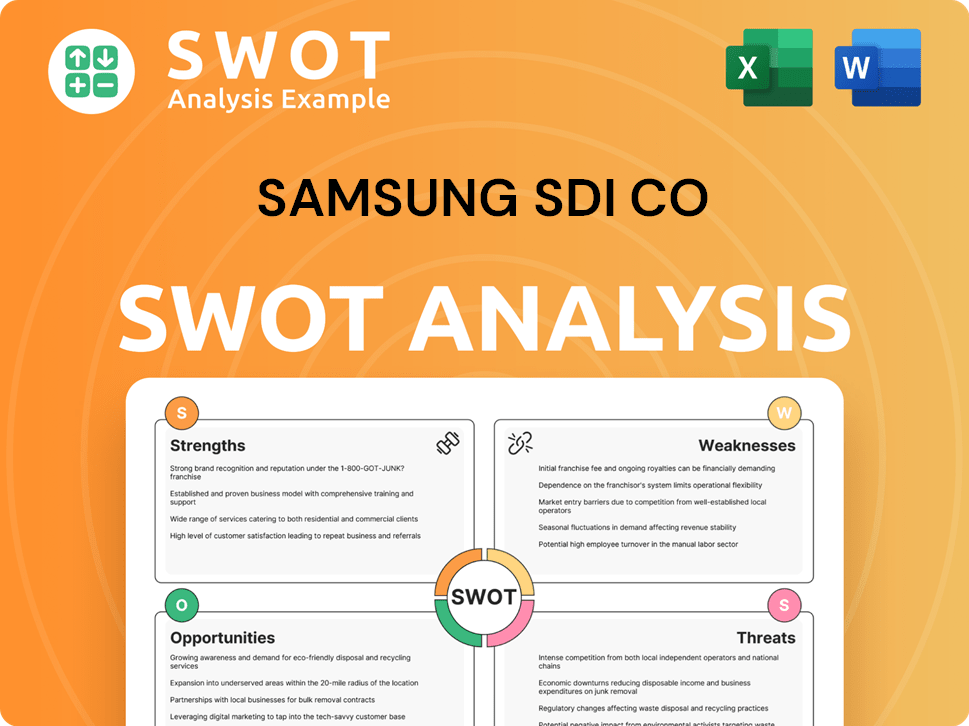
How Has Samsung SDI Co’s Ownership Changed Over Time?
The ownership structure of Samsung SDI has seen significant changes since its beginnings as a joint venture. The company transitioned into a publicly traded entity after its initial public offering (IPO), though it remains closely tied to the broader Samsung Group. This evolution reflects strategic shifts and market dynamics impacting the company's direction and stakeholder influence. Understanding the evolution of Samsung SDI's marketing strategy is also crucial.
As of the first quarter of 2025, Samsung Electronics Co., Ltd. remains a major shareholder of Samsung SDI. This corporate ownership structure is typical within the Samsung conglomerate. It allows for strategic alignment and control among its affiliates. The influence of these major shareholders is evident in the company's strategic decisions and investments.
| Ownership Category | Stakeholders | Approximate Percentage (Early 2024) |
|---|---|---|
| Major Shareholder | Samsung Electronics Co., Ltd. | Significant |
| Institutional Investors | Asset Management Firms, Mutual Funds, Index Funds | Variable, but substantial |
| Individual Insiders | Executives, Lee Family (through Samsung Group) | Less significant than corporate holdings |
Institutional investors, including asset management firms and mutual funds, also hold a considerable portion of Samsung SDI's shares. Their investment strategies and market activities cause fluctuations in their exact percentages. Individual insider ownership, which includes executives and members of the founding family, also plays a role, though their direct holdings might be smaller compared to the corporate holdings by Samsung affiliates. These varying ownership stakes influence the company's strategic direction and financial performance.
The ownership of Samsung SDI is primarily influenced by Samsung Electronics and institutional investors.
- Samsung Electronics is the major shareholder.
- Institutional investors hold a significant portion of the shares.
- Changes in ownership impact strategic decisions.
- Market capitalization was approximately 35.8 trillion KRW as of March 2024.
Samsung SDI Co PESTLE Analysis
- Covers All 6 PESTLE Categories
- No Research Needed – Save Hours of Work
- Built by Experts, Trusted by Consultants
- Instant Download, Ready to Use
- 100% Editable, Fully Customizable
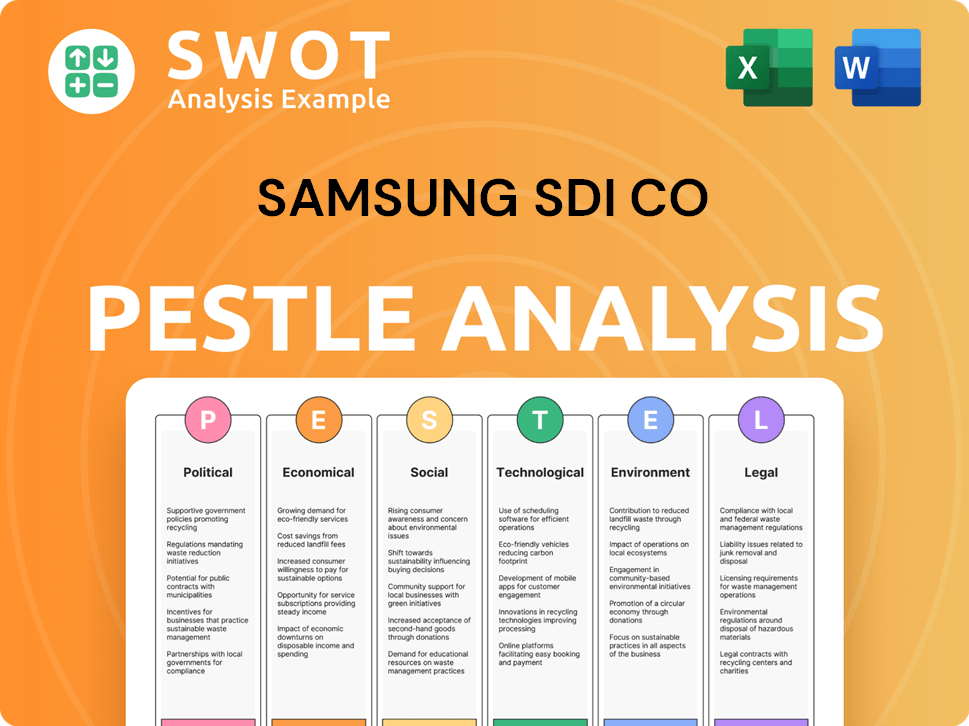
Who Sits on Samsung SDI Co’s Board?
The Board of Directors of Samsung SDI is crucial for its governance, typically comprising a mix of internal executives, representatives from major shareholders, and independent directors. While specific board member details for 2024-2025 require up-to-date corporate filings, the board generally includes key figures from Samsung SDI's management, such as the CEO and CFO, alongside non-executive directors. Given the significant stake held by Samsung Electronics, it's highly probable that representatives from Samsung Group or its affiliates hold board positions, ensuring alignment with the broader conglomerate's strategic goals. Independent directors are also appointed to ensure corporate transparency and adherence to governance best practices.
As of the latest available data, details on the exact composition of the board for 2024-2025 would be found in the company's annual reports and filings. These documents provide the most current information on the individuals serving on the board, their roles, and any changes that have occurred. Investors and stakeholders can access this information to understand the leadership structure and governance of Samsung SDI.
| Board Member | Title | Affiliation |
|---|---|---|
| Choi Yoon Ho | CEO | Samsung SDI |
| Kim Jong-seong | CFO | Samsung SDI |
| Lee Jae-yong | Director | Samsung Electronics (Likely) |
Samsung SDI operates under a one-share-one-vote structure for its common shares, meaning each share generally carries equal voting rights. However, the influence of Samsung Electronics and other Samsung Group affiliates, through their substantial shareholdings, effectively grants them outsized control. This is a common characteristic of South Korean chaebols, where cross-shareholdings and complex ownership structures allow founding families and their associated entities to exert significant influence despite not always holding a majority of direct shares in every listed entity. There have been no widely reported proxy battles or activist investor campaigns specifically targeting Samsung SDI in 2024-2025 that have significantly reshaped its decision-making processes. The company’s governance tends to be stable, largely due to the dominant influence of its corporate parent. For more insights, you can explore an article about Samsung SDI Co. 0
The ownership structure of Samsung SDI is primarily influenced by its parent company, Samsung Electronics. This structure ensures that the strategic direction of Samsung SDI aligns with the broader goals of the Samsung Group.
- Samsung Electronics is the majority shareholder.
- Other institutional investors and public shareholders hold the remaining shares.
- The influence of Samsung Electronics is significant due to its substantial stake.
- The company's governance is stable due to the dominant influence of its corporate parent.
Samsung SDI Co Business Model Canvas
- Complete 9-Block Business Model Canvas
- Effortlessly Communicate Your Business Strategy
- Investor-Ready BMC Format
- 100% Editable and Customizable
- Clear and Structured Layout
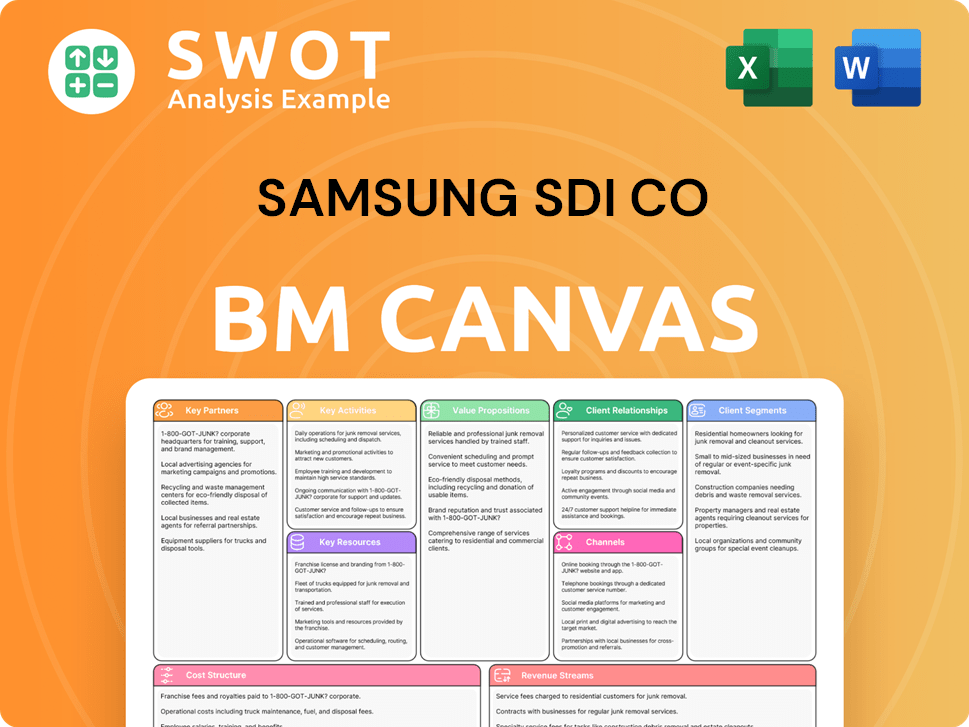
What Recent Changes Have Shaped Samsung SDI Co’s Ownership Landscape?
Over the past 3-5 years (2022-2025), several developments have influenced the ownership profile of Samsung SDI. The company has been focused on expanding its production capacity for electric vehicle (EV) batteries, including establishing joint ventures and new facilities in key markets, especially in the United States. These strategic moves, requiring significant capital, have attracted institutional investors looking to capitalize on the growth in the EV sector. This has led to shifts in the shareholder base, reflecting increased interest from major funds.
The company's commitment to growth is evident through ongoing capital expenditures and strategic alliances, which appeal to long-term investors. While there haven't been major share buybacks or secondary offerings that drastically altered its ownership structure, the overall trend indicates a strengthening position in the green energy transition. As a leading battery manufacturer, Samsung SDI benefits from this trend, drawing in investors focused on sustainable technologies. The business model of Samsung SDI is directly tied to these strategic investments and partnerships.
| Ownership Category | Details | Recent Trends (2022-2025) |
|---|---|---|
| Major Shareholders | Primary stakeholders | Increased institutional investment, particularly from funds focused on the EV and green energy sectors. |
| Institutional Investors | Investment firms, mutual funds, etc. | Growing stakes due to Samsung SDI's expansion in the EV battery market and its strategic alliances. |
| Parent Company | Samsung Electronics | Ongoing efforts within the Samsung Group to streamline ownership structures, impacting affiliates like Samsung SDI. |
The Samsung Group's efforts to streamline its ownership and enhance transparency have indirect effects on affiliates like Samsung SDI. The focus remains on strategic partnerships and technological advancements to maintain its competitive edge in the rapidly evolving battery market. There have been no public statements about planned succession or potential privatization/public listing that would significantly alter the current ownership structure in the immediate future. The company's focus remains on strategic partnerships and technological advancements to maintain its competitive edge in the rapidly evolving battery market.
The ownership structure is primarily influenced by the Samsung Group. Institutional investors are increasing their stakes. No major changes have been reported recently regarding share buybacks or secondary offerings.
Major shareholders include the parent company and various institutional investors. The exact percentages can fluctuate. Publicly available financial reports and filings provide details.
There's growing interest from investors in the EV and green energy sectors. Samsung SDI's strategic partnerships and capital expenditures attract long-term investors. These trends are reflected in its stock performance.
The focus remains on strategic partnerships and technological advancements. No immediate plans for major ownership changes have been announced. The company's performance is closely tied to the EV market.
Samsung SDI Co Porter's Five Forces Analysis
- Covers All 5 Competitive Forces in Detail
- Structured for Consultants, Students, and Founders
- 100% Editable in Microsoft Word & Excel
- Instant Digital Download – Use Immediately
- Compatible with Mac & PC – Fully Unlocked
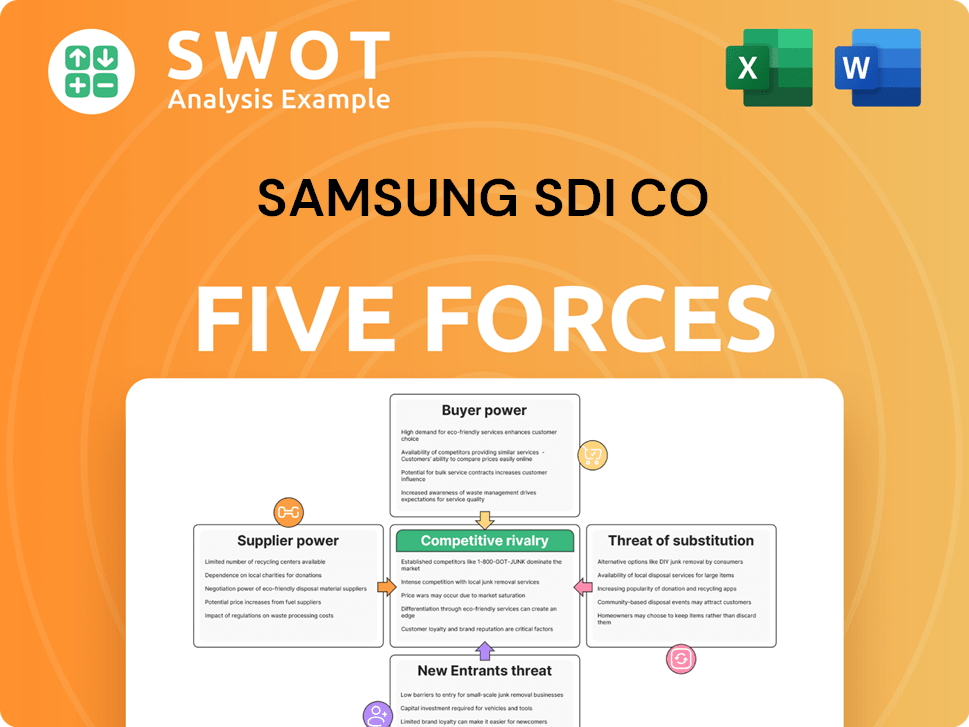
Related Blogs
- What are Mission Vision & Core Values of Samsung SDI Co Company?
- What is Competitive Landscape of Samsung SDI Co Company?
- What is Growth Strategy and Future Prospects of Samsung SDI Co Company?
- How Does Samsung SDI Co Company Work?
- What is Sales and Marketing Strategy of Samsung SDI Co Company?
- What is Brief History of Samsung SDI Co Company?
- What is Customer Demographics and Target Market of Samsung SDI Co Company?
Disclaimer
All information, articles, and product details provided on this website are for general informational and educational purposes only. We do not claim any ownership over, nor do we intend to infringe upon, any trademarks, copyrights, logos, brand names, or other intellectual property mentioned or depicted on this site. Such intellectual property remains the property of its respective owners, and any references here are made solely for identification or informational purposes, without implying any affiliation, endorsement, or partnership.
We make no representations or warranties, express or implied, regarding the accuracy, completeness, or suitability of any content or products presented. Nothing on this website should be construed as legal, tax, investment, financial, medical, or other professional advice. In addition, no part of this site—including articles or product references—constitutes a solicitation, recommendation, endorsement, advertisement, or offer to buy or sell any securities, franchises, or other financial instruments, particularly in jurisdictions where such activity would be unlawful.
All content is of a general nature and may not address the specific circumstances of any individual or entity. It is not a substitute for professional advice or services. Any actions you take based on the information provided here are strictly at your own risk. You accept full responsibility for any decisions or outcomes arising from your use of this website and agree to release us from any liability in connection with your use of, or reliance upon, the content or products found herein.